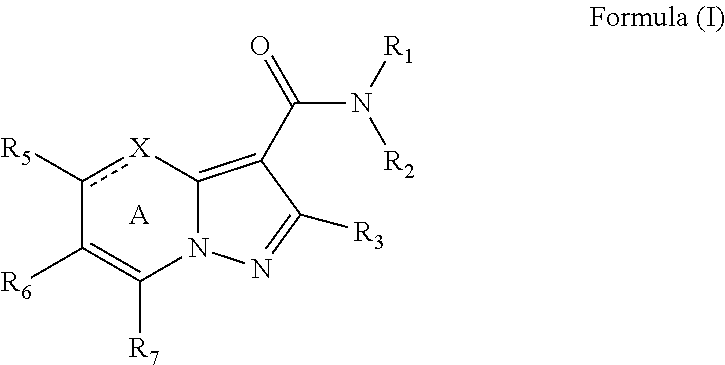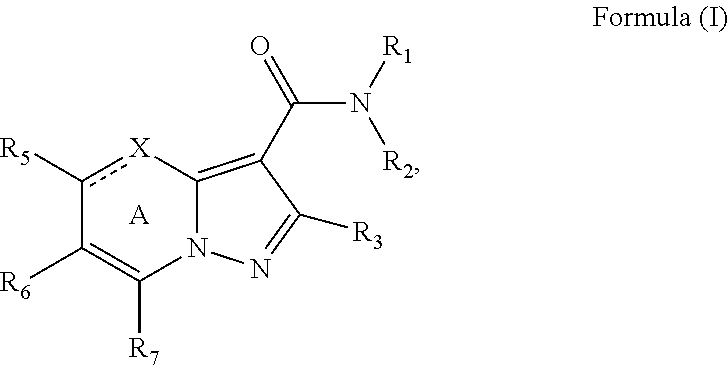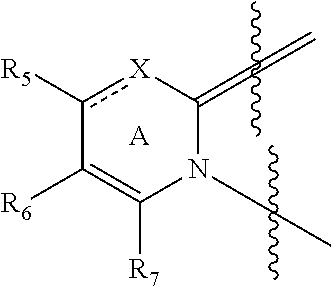Substituted pyrazolopyrimidines as glucocerebrosidase activators
- Summary
- Abstract
- Description
- Claims
- Application Information
AI Technical Summary
Benefits of technology
Problems solved by technology
Method used
Image
Examples
example 1
Synthetic Scheme for Preparing Substituted Pyrazolopyrimidines and Dihydropyrazolopyrimidines
[0092]The synthetic sequence (Scheme 1) used to generate the substituted pyrazolopyrimidines and dihydropyrazolopyrimidines provided herein starts with the condensation of a 1,3-diketone 6 with ethyl 3-amino-1H-pyrazole-4-carboxylate 7 in acetic acid. Such reactions have been reported previously. See for example WO 2008 / 134035 and Huppatz, J. L. Aust. J Chem. 1985, 38, 221-230. Initial efforts to simplify the evaluation of the amide SAR centered on the use of acetylacetone as the diketone to eliminate the formation of regioisomers (R1=R2=CH3). With unsymmetrical ketones a mixture of regioisomers (8, 9) forms which is typically separated by chromatography. Ester hydrolysis then provides an acid, which is coupled with amines or anilines to generate compounds (10, 11) for biological analysis.
example 2
Synthesis of N-(4-Ethynylphenyl)-5,7-dimethylpyrazolo[1,5-a]pyrimidine-3-carboxamide
Step 1. Synthesis of 5,7-Dimethylpyrazolo[1,5-a]pyrimidine-3-carboxylic acid (12)
[0093]
[0094]Pentane-2,4-dione (1.46 ml, 14.2 mmol), ethyl 3-amino-1H-pyrazole-4-carboxylate (2.00 g, 12.9 mmol) were heated in a sealed tube with acetic acid (10 ml) at 110° C. overnight. The reaction reached completion by LCMS (LC-MS: rt (min)=3.08). The acetic acid was removed by blowing air with the flask being heated to 75° C. The crude residue of ethyl 5,7-dimethylpyrazolo[1,5-a]pyrimidine-3-carboxylate (assumed to be 12.89 mmol) was suspended in MeOH (15 ml) and treated with 7.2 M sodium hydroxide (5.37 ml, 38.7 mmol). The mixture was heated to 80° C. (at this temperature the solid dissolved) and then stirred for 3 h. The reaction was cooled and the neutralized to pH 6-7. The slurry was filtered via a Buchner funnel under house vacuum, the solid residue was washed with water and then diethyl ether to obtain 5,7-dim...
example 3
Assay Protocol for Glucocerebrosidase Activity
[0097]qHTS Assay for Inhibitors and Activators of N370S glucocerebrosidase as a Potential Chaperone Treatment of Gaucher Disease: Primary Screen Confirmation
[0098]This is a fluorogenic enzyme assay with 4-methylumbelliferyl-beta-D-glucopyranoside as the substrate and N370S glucocerebrosidase from human spleen homogenate as the enzyme preparation. Upon the hydrolysis of this fluorogenic substrate, the resulting product, 4-methyllumbelliferone, can be excited at 365 nm and emits at 440 nm which can be detected by a standard fluorescence plate reader. Data were normalized to the controls for basal activity (without enzyme) and 100% activity (with enzyme). The AC50 values were determined from concentration-response data modeled with the standard Hill equation.
[0099]Human spleen homogenate is prepared as follows by homogenizing spleen with assay buffer containing 50 mM citric acid (titrated with potassium phosphate to pH 5.0), 100 mM potassiu...
PUM
| Property | Measurement | Unit |
|---|---|---|
| Volume | aaaaa | aaaaa |
| Time | aaaaa | aaaaa |
| Time | aaaaa | aaaaa |
Abstract
Description
Claims
Application Information
 Login to View More
Login to View More - R&D
- Intellectual Property
- Life Sciences
- Materials
- Tech Scout
- Unparalleled Data Quality
- Higher Quality Content
- 60% Fewer Hallucinations
Browse by: Latest US Patents, China's latest patents, Technical Efficacy Thesaurus, Application Domain, Technology Topic, Popular Technical Reports.
© 2025 PatSnap. All rights reserved.Legal|Privacy policy|Modern Slavery Act Transparency Statement|Sitemap|About US| Contact US: help@patsnap.com



